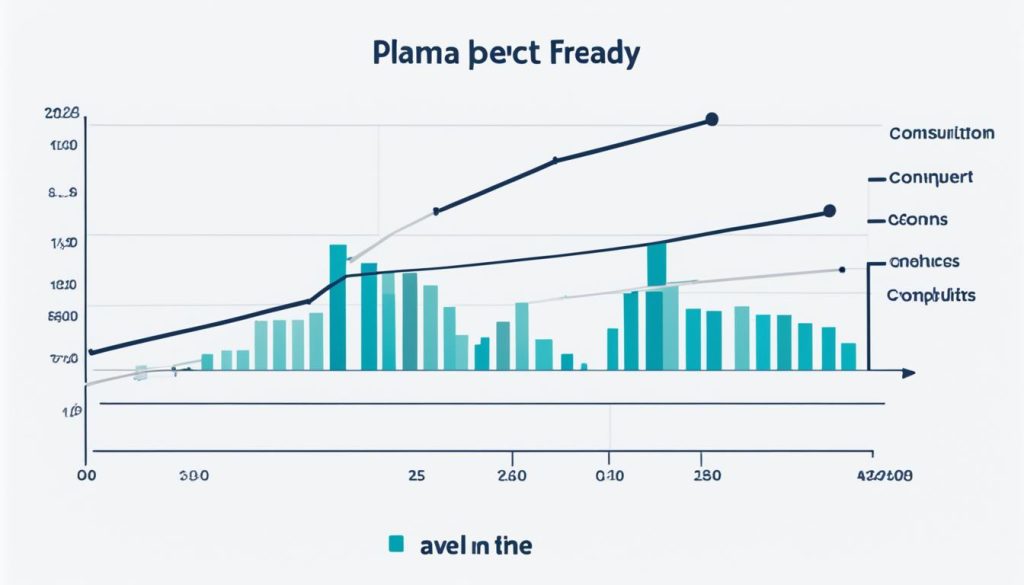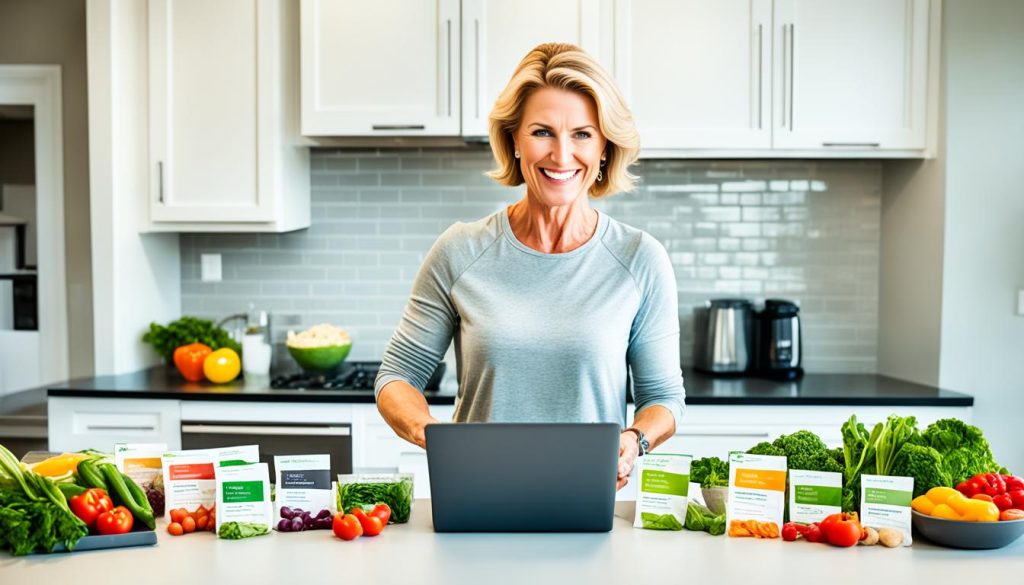Today, people’s lives are busier than ever. That’s why ready meals are so popular. They offer speed and ease. Over the past five years, ready meals have grown in popularity for both lunch and dinner, making up 15.3% of evening meals and 5.9% of lunch occasions1.
Even though their popularity has dipped a bit, they’re still more popular than in 2019. Cooking from scratch is often cheaper than buying these meals. But, people love ready meals for their time-saving benefits, nutritional value, and the chance to enjoy a “treat” at home1.
Yet, the trend of buying ready meals has dropped in 2022 and 2023. This is because fewer people are shopping, except for those over 651.
Key Takeaways
- Convenience meals have seen significant growth in recent years, accounting for 15.3% of evening meals and 5.9% of lunch occasions.
- Almost a fifth of consumers lack confidence in providing nutritionally balanced meals daily.
- Only 39% of consumers enjoy cooking and are confident in preparing a wide variety of dishes.
- Ready meal purchases have started declining, with volumes declining by 1.4% in 2022, excluding consumers aged 65 and over.
- Consumers are trading down tiers and switching between proteins to save money on red meat purchases.
The Real Cost of Convenience Foods: Are Meal Kits Worth It?
Ready meals and convenience foods are very tempting. They save time and are easy to get. In recent years, they’ve become a big part of our meals2. People like them because they’re quick, nutritious, and cheaper than eating out.
Understanding the Appeal of Ready Meals
Busy people and families often turn to ready meals to save time. These meals are perfect for those who want a fast and easy meal2. But, people are buying them less now, except for seniors over 652. This shows that cost, nutrition, and cooking habits affect what we choose to eat.
Factors Influencing Meal Kit Purchases
Meal kits are a new choice between ready meals and cooking from scratch. They send you ingredients and recipes to make a meal3. They might cost more than buying groceries, but they can save food, introduce new recipes, and meet dietary needs3.
Meal kits can be pricey, but sometimes not much more than buying groceries2. For some, the convenience and less food waste make them worth it3. Whether to choose meal kits or grocery shopping depends on what you value most, like time, budget, and trying new foods.
“Meal kits reduce food waste by 27% compared to meals made from ingredients purchased at a grocery store.”3
As convenience foods change, knowing their true cost and what drives our choices is key. It helps us make better decisions about our meals and eating out234.
Assessing the Decline in Ready Meal Consumption
Ready meals are still popular for their ease, but their demand has dropped in recent years5. This drop is mainly due to fewer shoppers, especially among most age groups. However, those 65 and older are still buying the most ready meals, even if the total amount bought has gone down5.
Volume Changes by Demographic
The 65 and over group buys the most ready meals, despite a drop in total purchases5. Younger people, like those 35-44, are buying more in-store meal kits. This shows a shift in what people prefer6.
Protein Trends in Ready Meals
Chicken is the top protein in ready meals, making up 46.4% of all sales5. Beef is still big, but all red meats, including pork, are seeing fewer sales. Pork is seeing the biggest drop5.
| Protein Type | Ready Meal Volume Share |
|---|---|
| Chicken | 46.4% |
| Beef | Largest actual volumes among red meats |
| Pork | Greatest decline in ready meal volumes |
Changes in who buys ready meals and what they prefer show the market is evolving. Companies and stores are changing to attract health-focused and budget-savvy shoppers56.
Evaluating the Cost-Effectiveness of Meal Kits
Many people are looking for ways to save money, making meal kits a big topic. They offer convenience and save time, but they’re pricier than buying groceries. This price difference is something to think about7.
Let’s look at the cost difference between meal kits and groceries. Budget-friendly options like EveryPlate cost about $5 to $8 per meal7. This is just a bit more than buying the same ingredients at a midrange store7. The extra cost might be worth it for the time saved.
But, not all meal kits are the same. Premium services like Sunbasket and Green Chef charge around $13 to $14 per meal7. These meals use high-quality, organic ingredients. If you’re watching your budget, these might not be the best deal.
To get the most out of meal kits, look at the number of servings, discounts for new customers, and the meal’s nutritional value8. Green Chef, for example, offers big discounts for new users, making meals as cheap as $4.808.
The meal kit market is growing because more people live alone and want easy, healthy meals at home9. This means we might see more affordable meal kit options in the future9.
Whether meal kits are a good deal depends on what you need and what each service offers. Think about the size of the servings, the quality of the ingredients, and any discounts. This way, you can decide if meal kits are worth it for you and your meals.
Meal Kit Delivery Services: A Closer Look
Meal kit delivery services have become very popular lately. They offer a way to cook at home without the trouble of planning meals and buying groceries. Factor10 is one such service that stands out with its wide variety of meals. These include Protein Plus, Calorie Smart, and Keto-friendly options10.
Preparing and Tasting Factor Meals
Signing up for Factor is easy, letting customers tailor their deliveries and manage their subscriptions. The meals come ready to cook, needing just a microwave to prepare. This makes them a great choice for busy people10. People who try Factor meals often talk about the quality of the ingredients. They mention how fresh and full of flavor they are. The chicken dishes are especially loved for their juicy and tender taste10.
Pricing and Sustainability of Factor
Prices for Factor meals range from $11.49 to $13.99 per serving, based on the plan you choose10. This might be a bit more than cooking at home, but Factor cares about the planet. They use packaging that can be recycled, reused, or composted to lessen their environmental impact10.
When looking at the value of meal kit services like Factor, think about more than just the cost per meal. Consider the time saved, less food waste, and the convenience they offer11. For those who eat out a lot or have trouble with meal planning, Factor can be a smart choice. It helps with healthier eating habits too. 101211,,
Choosing a meal kit service like Factor depends on your lifestyle, budget, and what you like. Even though it might cost more than buying groceries, the ease and health benefits could be worth it for some people11.
Conclusion
Throughout this article, we’ve seen how meal kits and ready meals are popular for their convenience and time-saving benefits. But, it’s crucial to look at the real cost of these convenience foods. The drop in ready meal sales shows that cost, nutrition, and cooking habits are affecting what people choose to buy13.
Looking at the cost-effectiveness of meal kits, the protein in ready meals, and the green efforts of meal delivery services helps you make better choices. With tight budgets, meal kits and ready meals must offer great value and health benefits to stay popular1415.
Your decision between meal kits, convenience foods, and home cooking depends on what you like, your health needs, and your budget. By considering the good and bad of each choice, you can find the best mix of time-saving and healthy eating for you and your family. The meal kit and ready meal market is always changing, so keep up and pick what fits your values and life.
FAQ
What are the key factors that influence the appeal of ready meals?
How have overall ready meal purchases fared in recent years?
What protein trends have been observed in ready meals?
How can meal kits and ready meals justify their higher price point to remain appealing?
What are the key features and benefits of the Factor meal kit delivery service?
Source Links
- Are cost conscious consumers still reaching for ready meals?
- Meal Kits vs. Groceries: A Dollar-to-Dollar Investigation
- Pros and cons of meal kits
- Are meal kits worth the cost?
- What is better meal kits or takeout?
- Examining Meal Kit Consumers
- Are Meal Kits Actually Cheaper Than Grocery Shopping? I Did the Math
- How do meal kits work?
- Home chef meal kits: Product attributes, perceived value and repurchasing intentions the moderating effects of household configuration
- Serving convenience: Are meal delivery kits worth it?
- What is better meal kits or takeout?
- Are meal kits worth it?
- Acceptability and Willingness to Pay for a Meal Kit Program for African American Families with Low Income: A Pilot Study
- Impacts on the Interest Level of Consumers Toward Meal Kit Delivery Services
- Reddit – Dive into anything


